Can You Untie Your Tubes? 2025 Powerful Guidance for Family Planning
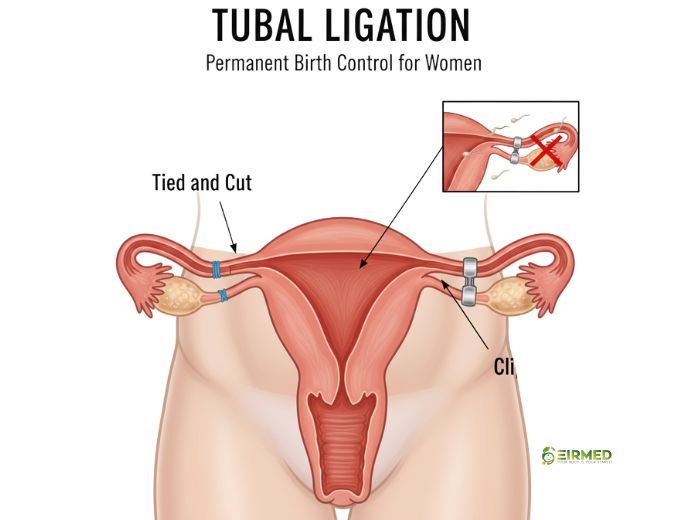
How 5 Key Factors Decide if You Can You Untie Your Tubes and Have a Baby
 If you’re reading this, it means your heart has changed its mind. You may have chosen to get your tubes tied, the procedure called tubal ligation in the past, thinking your family was complete. But life often brings new dreams, new partners, or a desire to hold another child. Now, you have a huge question burning in your mind: “Can you untie your tubes?”
If you’re reading this, it means your heart has changed its mind. You may have chosen to get your tubes tied, the procedure called tubal ligation in the past, thinking your family was complete. But life often brings new dreams, new partners, or a desire to hold another child. Now, you have a huge question burning in your mind: “Can you untie your tubes?”
This is one of the most important questions a person can ask about their fertility. The good news is that for many, the answer is a hopeful yes, through a specialized surgery called Tubal Ligation Reversal (TLR).
At EIRMED, a leading website for fertility and infertility-based support and products, we understand this journey is personal and requires clear, honest, and deep details. This expert guide will walk you through the 5 most important factors that decide if the surgery is right for you and what your best path to pregnancy truly is.
1. What Determines If You Can You Untie Your Tubes? The Type of Ligation Matters
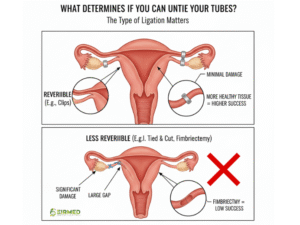 The very first step in determining if a tubal reversal surgery is possible is knowing how your tubes were tied. The success of the reversal hinges entirely on how much healthy fallopian tube is left to repair.
The very first step in determining if a tubal reversal surgery is possible is knowing how your tubes were tied. The success of the reversal hinges entirely on how much healthy fallopian tube is left to repair.
The success of a Tubal Ligation Reversal (TLR) depends heavily on what kind of sterilization surgery you had in the first place. Think of the fallopian tube the path the egg takes as a delicate road. Some sterilization methods just place a temporary roadblock, while others permanently damage the highway.
The Best Candidates for Reversal
- Clips or Rings: Methods that used a small clip (like Filshie clips) or a ring (like Falope rings) to pinch the tube are generally the easiest to reverse. Why? Because they damaged the smallest section of the tube, leaving a longer, healthier segment to reconnect. This gives surgeons the best chance for a successful repair.
- Pomeroy Method (Tied and Cut): This is where a small loop of the tube was tied off and cut. If the surgeon left a good length of tube behind, the reversal can still be very successful.
When Reversal is Difficult or Impossible
- Cautery (Burned Tubes): If your tubes were closed by burning (electrocautery), this often destroys a long section of the tube. When too much healthy tube tissue is gone, there isn’t enough left to reconnect safely, which makes the reversal much harder and less likely to work.
- Total Removal (Salpingectomy): Some modern procedures remove the entire fallopian tube. If your tubes were completely removed, it is impossible to perform a tubal ligation reversal.
Your Action Step: The very first thing you need to do is get a copy of your original tubal ligation surgery report. This report holds the key to knowing if you can you untie your tubes.
2. Age is Everything: How Does It Affect Success?
 When you’re considering a tubal ligation reversal, your age is one of the single most important factors. It’s not just about the surgery working; it’s about your body’s natural ability to get pregnant afterward.
When you’re considering a tubal ligation reversal, your age is one of the single most important factors. It’s not just about the surgery working; it’s about your body’s natural ability to get pregnant afterward.
As women get older, the quality and quantity of their eggs naturally decrease. This is called ovarian reserve. Even if the surgeon perfectly reconnects your tubes, getting pregnant may be difficult if your eggs are older.
For women in their late 30s and early 40s, the time it takes to get pregnant after reversal (which can be a year or more) may be time you don’t have. This is why for women in this age group, fertility specialists often recommend In Vitro Fertilization (IVF), as it can be a quicker and more effective way to conceive.
3. How is the Reversal Performed? The Surgeon’s Skill
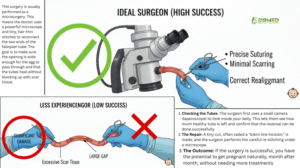 A Tubal Ligation Reversal is a very detailed and careful surgery. It’s not like getting a knee replaced; it’s a procedure that requires extreme precision.
A Tubal Ligation Reversal is a very detailed and careful surgery. It’s not like getting a knee replaced; it’s a procedure that requires extreme precision.
This surgery is usually performed as a microsurgery. This means the doctor uses a powerful microscope and tiny, hair-thin stitches to reconnect the two ends of the fallopian tube. The goal is to make sure the opening is wide enough for the egg to pass through and that the tubes heal without blocking up with scar tissue.
Key Steps in the Reversal Surgery
- Checking the Tubes: The surgeon first uses a small camera (laparoscope) to look inside your belly. This lets them see how much healthy tube is left and confirm that the reversal can be done successfully.
- The Repair: A tiny cut, often called a “bikini line incision,” is made, and the surgeon performs the careful re-stitching under a microscope.
- The Outcome: If the surgery is successful, you have the potential to get pregnant naturally, month after month, without needing more treatments.
Choosing a fertility specialist or microsurgeon who does this surgery often is essential. Their experience directly impacts your chance of a successful outcome and your ability to avoid later complications.
4. What Are the Costs: TLR vs. IVF?
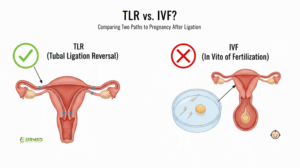 Money is a practical reality in every family-building decision. When deciding if you can you untie your tubes, you must compare the cost of reversal surgery to the cost of In Vitro Fertilization (IVF).
Money is a practical reality in every family-building decision. When deciding if you can you untie your tubes, you must compare the cost of reversal surgery to the cost of In Vitro Fertilization (IVF).
Tubal Ligation Reversal (TLR) Cost:
- This is typically a one-time cost that usually ranges from $8,000 to $15,000 or more, depending on the location and the surgeon.
- The benefit: If it works, you get a lifetime of natural fertility for that one fee. This makes it more cost-effective if you plan to have more than one child.
In Vitro Fertilization (IVF) Cost:
- This is a cost per cycle. One round of IVF can cost $12,000 to $25,000.
- The benefit: IVF offers a higher chance of success per attempt and is often faster. It is usually the better choice for older women because of the speed and higher per-cycle success rate.
The Insurance Problem: Sadly, most insurance companies in the US consider both a tubal ligation reversal and IVF to be “elective” procedures, meaning they usually do not cover the costs. You should always check your personal insurance plan, but prepare for this to be an out-of-pocket expense.
5. What is the Biggest Risk After Reversal?
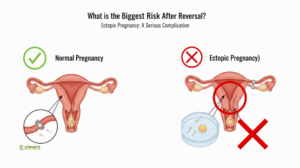 You must understand the most important risk when you try to get pregnant after a tubal ligation reversal: an Ectopic Pregnancy.
You must understand the most important risk when you try to get pregnant after a tubal ligation reversal: an Ectopic Pregnancy.
An ectopic pregnancy happens when the fertilized egg (the baby) tries to implant and grow outside the uterus, usually in the fallopian tube itself. This is a very serious medical emergency because the tube cannot hold a growing pregnancy.
Why the Risk is Higher After Reversal:
When the fallopian tubes are reconnected, sometimes the delicate inner lining, which helps move the egg along, is damaged. This damage can allow the sperm to get through to the egg, but it may not let the fertilized egg travel all the way back to the uterus. It gets stuck in the tube.
- The risk of an ectopic pregnancy after a successful TLR is generally 2% to 7% (higher than in women who haven’t had their tubes tied).
- What you must do: If you have a successful tubal ligation reversal and you get a positive pregnancy test, you must call your doctor immediately. They will do an early ultrasound to make sure the pregnancy is safely inside your uterus. This early check-up is absolutely critical for your health.
Decision Summary: TLR vs. IVF
The choice between a Tubal Ligation Reversal and IVF depends on your unique situation.

Eirmed is an informational platform dedicated to providing reliable, science-based insights on male and female fertility, reproductive health, and natural conception.

Interesting read! It’s good to see platforms
Adderall Online Without Doctor Prescription